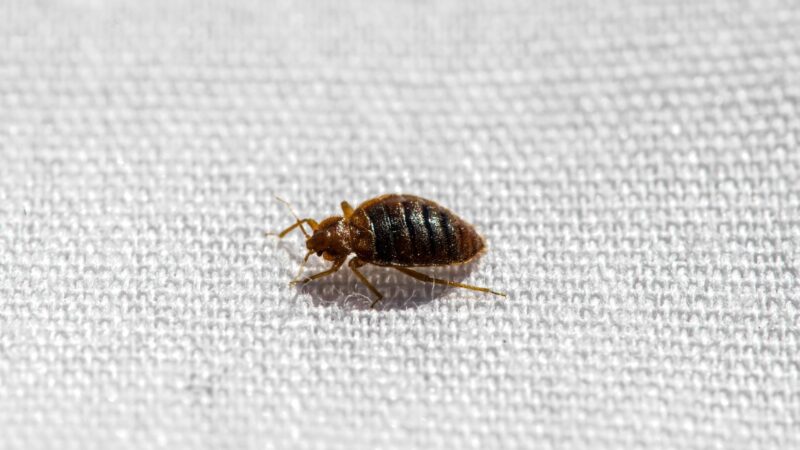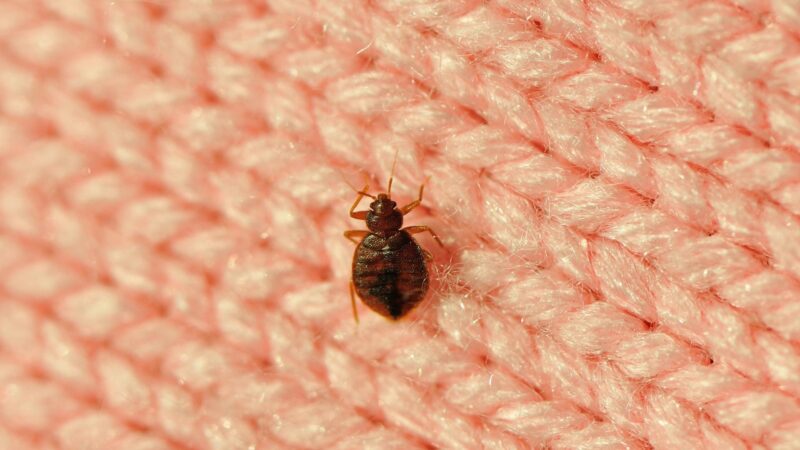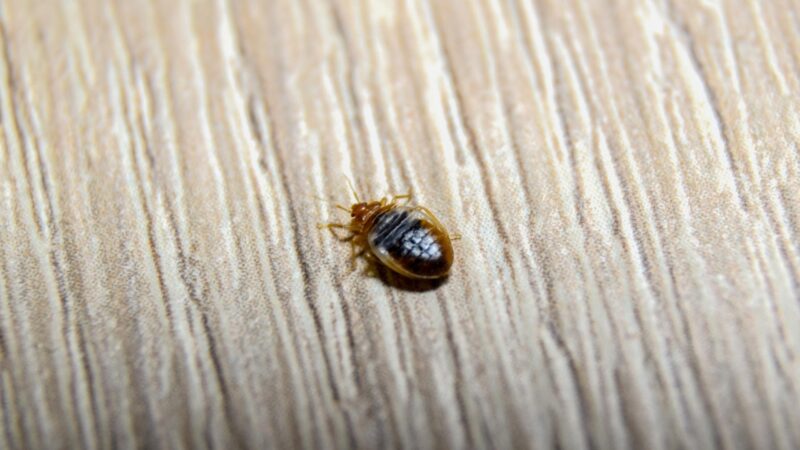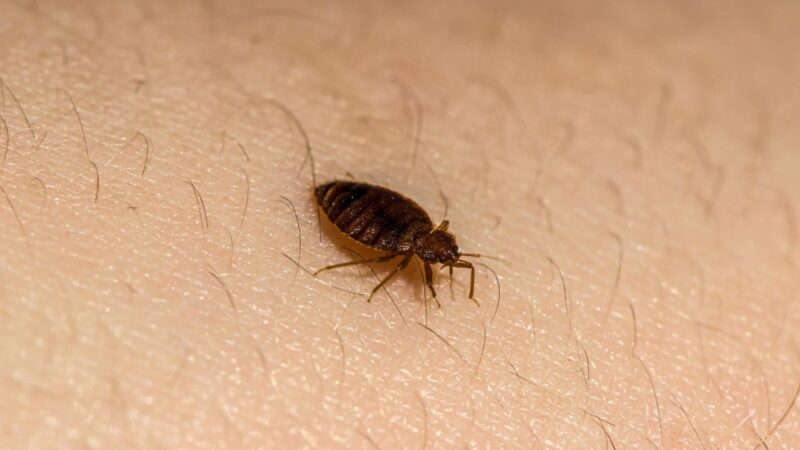Just like most insects, bed bugs have males and females, and they engage in sexual reproduction. This means that females should have fertilized eggs before they can reproduce.
What’s the difference between male and female bed bugs? The only difference between male and female bed bugs is their abdomen. Female bed bugs have a round abdominal tip, while males have a pointed end on their abdomen. Aside from that, both sexes look the same, and you can mistake one for the other.
As we all know, most bed bugs feed mainly on human blood, and their bites can be extremely itchy and painful. But does it matter if the bite came from a male bed bug or a female?
How to Tell Whether a Bed Bug Is Male or Female?

Male and female bed bugs almost look the same. Both sexes of newly hatched bed bug nymphs are about 1/16 inches (1.58 mm.) long and have clear to light color bodies.
Once they start to feed on human blood, these baby bed bugs can grow up to 1/6 inches (4.23 mm.) long, and their body will turn yellowish-white.
Adults of both sexes of bed bugs are about 1/4 inches (6.35 mm.) long. They have flat and mahogany to rusty brown bodies when hungry.
Regardless of gender and age, their bodies will turn red and become bigger and longer after feeding but will go back to their original color and shape after pooping.
Adult and baby bed bugs don’t have wings, so they cannot fly or jump, but they can crawl fast and easily hide. Since male bed bugs don’t lay eggs, you will not encounter an infestation once they enter your house. Nonetheless, their bites are as painful as that of females.
When it comes to habitat, male and female bed bugs can live together or alone. They can be found in dark, secured areas inside the house but usually near their food source.
To tell whether a bed bug is male or female, take a little closer at them. Both of them have short, golden hairs on their bodies but male bed bugs have a pointed end on their abdomen.
On the other hand, female bed bugs have a round abdominal tip. Other than that, there is no physical difference between them.
Do You Need Two Bed Bugs to Multiply?
You need two bed bugs so that they can multiply – one male and one female. Nevertheless, you only need one fertilized female bed bug to cause an infestation inside your house.
Once she has laid eggs, and some nymphs will become male adults, she will mate with them. Eventually, bed bugs will multiply.
How Do Bed Bugs Mate?
The mating behavior of bed bugs is somehow unique and violent. Instead of inserting his hardened reproductive organ into the female genitalia, a male bed bug will stab it on the right side of his female partner.
The male sperm will be released inside her body cavity. This sexual act is called traumatic insemination.
The sperm of the male bed bug will then travel to the ovaries, thus fertilizing the female’s eggs. The stabbing process will then result in a wound inside the female’s body and will cause a scar.
Interestingly, females that have been stabbed only once produce eggs 25% more than those stabbed multiple times.
How Fast Do Bed Bugs Spread?

Contrary to what many people think, bed bugs don’t spread quickly. Female bed bugs lay about 2-5 eggs a day or 200-500 eggs in their lifetime.
Eggs hatch within 10-15 days, and it takes about 5 weeks to 4 months for bed bugs to complete their life cycle. Hence, it takes months before an infestation can occur.
Nevertheless, bed bugs can spread from one place to another without being obvious.
Although they don’t live in humans, they may be accidentally brought home through infested wooden furniture, electronic appliances, clothes, and personal belongings. This is why a lot of people think bed bugs spread fast.
Where Do Female Bed Bugs Hide?

At home, female bed bugs hide in cracks within the bed frame, furniture near the bed, under mattresses, behind baseboards, and in crevices within the walls.
In schools and offices, they hide under and behind the chairs and tables, where people stay most of the time. Although rare, bed bugs can also hide in restaurants.
Do Both Male and Female Bed Bugs Bite?

Male and female bed bugs bite since both of them need to suck human blood to survive. They also need a blood meal before they can reproduce. Bed bug nymphs pass through five instar stages.
Both sexes should take a blood meal at every nymphal stage so they can molt (shed skin) and grow into adults.
Related: Bed Bug Bites: How to Treat Bed Bug Bites and Prevent Them
Are Male Bed Bugs Worse Than Females?
Generally speaking, male and female bed bugs are equally worse. Regardless of sex, bed bug bites are not painful at first. This is because when bed bugs bite, they inject a natural anesthetic into the skin of their victim.
People have different reactions to bed bug bites, and some of them don’t have any reactions at all.
However, female bed bugs tend to be worse than males in terms of reproduction. Obviously, male bed bugs don’t lay eggs, and they cannot cause an infestation without females.
They should also mate with a female that has just taken a blood meal. Otherwise, she will not produce eggs even if the male has sperm.
Signs You Have Bed Bugs
Bed bugs are very quick in hiding in dark, small cracks, especially in the bed. One morning, you may wake up feeling something you think are bed bug bites. But are they really bed bug bites?
To help you decide, here’s what bed bug bites look like, along with the obvious signs that you have bed bugs at home.
1. Bed Bug Bites
Bed bug bites look like flea and mosquito bites. Skin swelling and itchiness can also be due to cosmetics, soaps, and other household products. Also, some people who have been bitten by bed bugs don’t show any symptoms.
Most bed bug bites form a straight line, though. But still, you should investigate further.
2. Bed Bug Cast Skins
Bed bug cast skins are hard, mostly reddish-brown, and appear once nymphs are molting. Some of them are translucent and look like empty bodies of bed bugs.
Adult bed bugs don’t shed skin, but it doesn’t mean that all the bed bugs in your home are nymphs. Therefore, you can have both of them at the same time.
3. Bed Bug Eggs
Bed bug eggs are white, oval, and about 1/16 inches long. These pinhead-sized eggs are coated with a sticky substance, which dries out and sticks to the area where they are deposited.
They are laid either singly or in batches in areas where bed bugs hide. Five-day-old bed bug eggs will have obvious eyespots.
4. Bed Bug Poop
Bed bug feces are dark spots that look like marks done by a fine felt-tipped marker. These marks are actually blood that bed bugs have ingested and expelled after they are done feeding.
Bed bug poop is usually found near their food source and hideouts. You may also see them in your blanket and pillows.
5. Live and Dead Bed Bugs
Seeing live bed bugs is the most obvious sign that you already have them. But then, seeing a single bed bug most likely means that there are more of them hiding somewhere.
Meanwhile, seeing some dead bugs without doing anything strongly suggests that you accidentally rolled over them while you were sleeping.
6. Bed Bug Smell
Bed bugs release a distinct moldy odor, which can be stronger during heavy infestations. Although some people may not smell it, a well-trained dog can smell all life stages of bed bugs.
Such dogs have a 97% accuracy and tend to be more efficient than humans since they don’t need to see live bed bugs to smell them.
Frequently Asked Questions
Can You Feel Bed Bugs Crawling?
Although possible, you may not always feel the bed bugs while they are crawling on your skin. To start with, they usually attack at night when people are already sleeping.
But even if you are awake, you may not still feel the crawling sensation unless there are lots of them. Baby bed bugs are also too small to feel their legs.
Can Bed Bugs Live In Pillows?
Bed bugs can live in pillows, as well as mattresses, blankets, and bedsheets. However, they are very unlikely to stay in areas where you can see them.
Instead, they will hide in edges or corner shields of fabrics, in the box spring seams, joints of your bed frame, or at the side of your pillow-top mattress.
Where Do Female Bed Bugs Lay Eggs?
Female bed bugs lay eggs on rough surfaces such as paper and wood located near the sleeping and resting areas of humans. They prefer dark, secure areas where people cannot easily find them.
In bedrooms, bed bug eggs are usually deposited behind baseboards, under mattresses, cracks, and joints in the bed frame.
What Do Bed Bugs Hate?
Bed bugs are very attracted to human sweat and odors, which explains why they are mostly hiding in beds. These notorious bloodsuckers cannot hear sound nor can they create sounds.
However, they can sense vibrations. Meanwhile, here are some scenarios that bed bugs hate or things that can repel them:
1. Bright Lights
Aside from being nocturnal creatures, bed bugs are also naturally photophobic. This means that they hate bright lights and choose dark areas as their resting areas.
This is why bed bugs escape if you spot them with a flashlight. But again, most hungry bed bugs will come out in the light if they sense a food source.
2. High Temperatures
Bed bugs are very attracted to human body heat, and they can detect heat at a distance of 4 centimeters. But according to several studies, they respond negatively once they are exposed to temperatures 40°C (104°F) and above.
At this point, their feeding behavior will be slower, and they can no longer reproduce.
3. Diatomaceous Earth (DE)
Diatomaceous earth is odorless, all-natural pest control that crawling insect pests, such as bed bugs hate. Harris Food-Grade DE has no poison but kills bed bugs by damaging their exoskeleton, causing them to slowly die of dehydration. Bed bugs don’t need to ingest DE to get killed; they just need to walk on it.
- 100% Chemical-Free: Made from 5lbs of food-grade freshwater...
- OMRI Listed for Organic Use: Certified by the Organic Materials...
- Powder Duster Included - Powder duster in the bag for easy and...
- Powder Duster Included for Easy Application: Comes with a powder...
- Sourced and Packaged in the USA: Responsibly mined in Nevada and...
Related: How to Use Diatomaceous Earth for Bed Bugs: Tips and Guide
4. Strong Smell
Bed bugs hate the strong smell of bleach, rubbing alcohol, and some common food ingredients, such as garlic and vinegar.
According to a study, they also hate the scent of blood orange essential oil, citronella essential oil, clove essential oil, eucalyptus essential oil, lavender essential oil, and peppermint essential oil.
What Kills Bed Bugs Instantly?
There are many ways to kill bed bugs, but only heat treatment can kill them instantly. All life stages of bed bugs die once exposed to 45°C (113°F). For infested bed sheets, place them in a clothes dryer for about 30 minutes. For bed frames and mattresses, Mosche Handheld Steam Cleaner is an ideal choice.
- 【Powerful Steamer for Cleaning】The steamer for cleaning with...
- 【Hot Steamer for Cleaning】Our 1050 watts handheld pressurized...
- 【All Natural & No Chemical Steam Cleaner】 Say goodbye to...
- 【Multiple Surface Steam Cleaner】Our steam cleaners is best...
- 【11 Accessories Set Steam Cleaner】Our powerful steam cleaner...
Summary
Male bed bugs seem to be less troublesome than females, but it does not mean you should no longer control them. Bed bugs also appear in very clean houses, which means that practicing good sanitation is not enough.
You should patiently investigate where bed bugs are hiding and conduct efficient solutions.
List of Sources
Ashbrook, A. R., et al. (2019). Bed Bug Control: Heat and Cold. The Ohio State University.
Miller, D. M., Polanco, A., Rogers, J. (2013). Bed Bug Biology and Behavior. Virginia Cooperative Extension.
Vail, K., Barnwell, P. (2016). Bed Bugs Management and Prevention. University of Tennessee Extension.
Gouge, D. H., et al. (2014). Bed bugs. The University of Arizona.
Miller, D. M. How to Identify a Bed Bug Infestation. Virginia Cooperative Extension.
- How to Get Rid of Copperheads | Practical Guide - August 27, 2023
- How to Get Rid of Corn Snakes | What Makes Them Aggressive? - August 27, 2023
- How to Get Rid of Alligators | Safety Measures and Removal Methods - July 16, 2023


